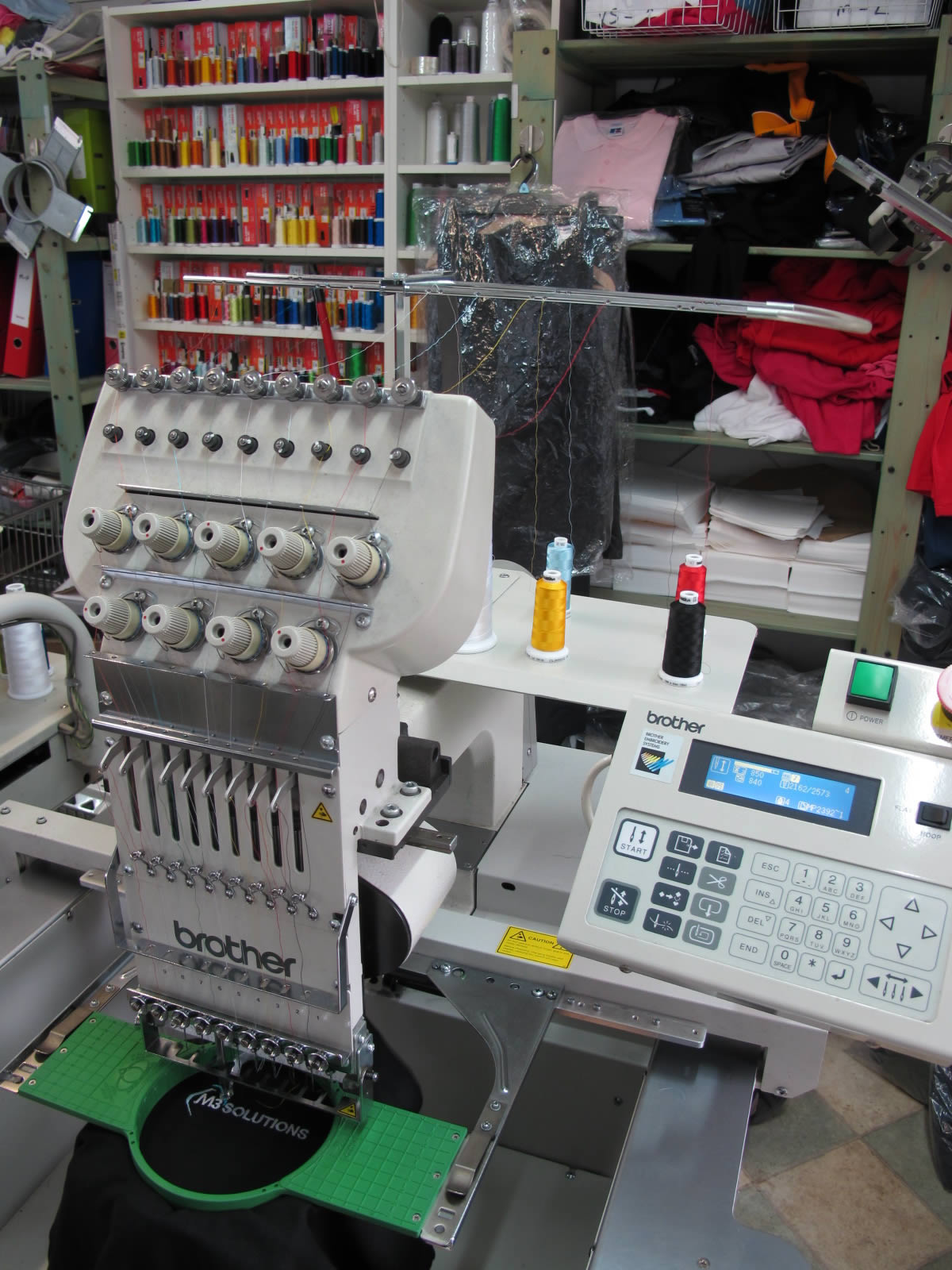Designing for workwear
You’re probably thinking this is not a subject that comes under the media banner but we’ve added workwear for the following reason.
You may seriously consider some form of workwear now or in the future and you will probably want to customise it for your business by adding your company logo.
Embroidery
What’s unique about workwear is that the embroidery process is the lowest resolution of all the medias mentioned previously.

Professional embroidery machine and colour thread spools
Embroidery resolution is about 40 stitches per inch (depending on cloth and thread) so if an embroidered design is required you may either want to consider simplifying your original corporate (logo) design or commissioning a simplified design option.
Thread colours are also restricted so if your logo uses an unusual colour that too may have to change. A limited number of embroidery threads can be matched to the Pantone Matching System (PMS) used in print. Another consideration is that most workwear is a dark colour so your corporate design may have to be reversed or framed to stand out.
TIP. The embroidery process uses delicate, fast moving needles and alignment tables so seek advice before purchasing garments yourself. Most workwear embroiderers can supply good quality products at surprisingly low costs.
Other workwear print options can be considered like vinyl lettering or heat transfer but commercial laundry processes are hostile environments so embroidered clothing is the most popular for long life and quality. There are two main thread types; Rayon and Polyester.
TIP. Rayon is semi-synthetic and best for hot washes. Polyester is synthetic so better for commercial cleaning processes that use bleach.
How does it work
You can select garments from a massive range of products; from neck ties to boiler suits, but the embroidery process remains basically the same. Every garment will have its own unique texture value which affects how your embroidery supplier selects the pitch of the stitch and thread type so commissioning an experienced supplier is a must.

Sample digitised stitch pattern for an embroidery machine
Converting your design
The logo, text or graphic are digitised, ie: converted to a matrix so that the embroidery machine knows what colour thread to put where. There’s usually a reinforcing panel on the reverse depending on cloth weight so avoid embroidery over pockets.
Also see: logo design and corporate design
Costs
On short runs expect to pay a set-up fee, which will cover the digitising process and any other work the supplier has to do to get your design up to specification.
TIP. Avoid small font use and intricate designs, they either won’t reproduce well or you will be charged for changing the design.
On longer runs the set-up costs are usually lost in the total cost of supply but you may want to purchase your digitised logo. There are several file formats used by embroidery machines but the most common is a dst file.
TIP. If you archive your dst file you can go to any embroidery supplier in the future thus avoiding the set-up fee.
A good embroidery company will show you a sample of your stitched design before they use it on your workwear. This is a great opportunity for you to check the quality, colours and general look of your design.
The vast majority of embroidery designs use no more than 4 coloured threads but you can use more if your design requires. The more colours, the slower the embroidery machine runs, so expect to pay for this if you supply a multi-colour design like a family crest.
Printed transfers
Very popular with one-off promotions. The design is printed in colour (CMYK) onto a carrier paper then transferred onto the garment using a heat press. Only your imagination can hold you back with this process but the print life is reduced with regular use/washing.
Vinyl cut designs
Some workwear suppliers use digital cutting machines to create a design that can then be heat pressed onto the garment. The material is hard wearing and colour safe but small detail is difficult to replicate. This is the sort of process used on replica football shirts when you want your name on the back of your shirt. This process has a restrictive range of colours but is a good solution for larger coverage.
Promoting your business
Adorning your staff with corporate workwear is a great way of promoting your business. It also adds a bit of security as the customised item becomes worthless to anyone else.
Workwear signage is most commonly used on polo shirts, sweatshirts, jumpers and shirts, but also consider other uses that could promote your company name not just by an employee but people you gift an item to: ties, umbrellas, tabards, mugs, mouse mats, safety glasses, hard hats, caps etc.
TIP. Whatever workwear or promotional item you use consider these basic rules: the item’s life, costs, where it’s going to be used, who’s going to see it (and why). Then decide what item is going to give you best value for money and profile your business in the best way possible.
REMEMBER. Your potential new customer may see your staff workwear before they meet you. They may even decide not to use you if your staff appear untidy!
Keep your workwear clean and smart – first impressions are the most lasting.

